Review of China's scientific research progress in polar meteorology in the last 30 years
中国科学家的秘密作文英语
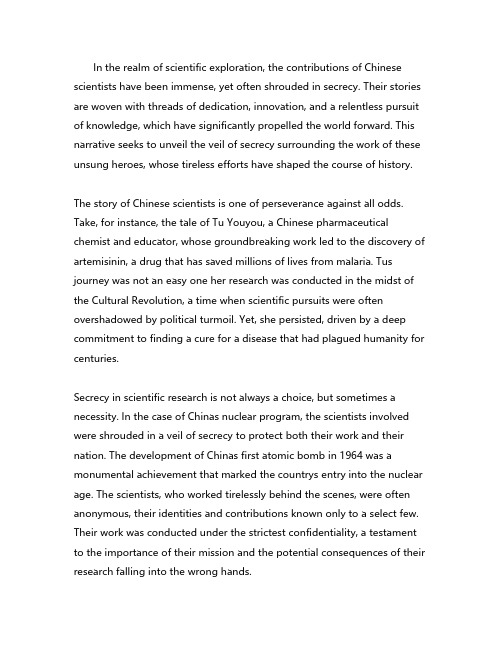
In the realm of scientific exploration,the contributions of Chinese scientists have been immense,yet often shrouded in secrecy.Their stories are woven with threads of dedication,innovation,and a relentless pursuit of knowledge,which have significantly propelled the world forward.This narrative seeks to unveil the veil of secrecy surrounding the work of these unsung heroes,whose tireless efforts have shaped the course of history.The story of Chinese scientists is one of perseverance against all odds. Take,for instance,the tale of Tu Youyou,a Chinese pharmaceutical chemist and educator,whose groundbreaking work led to the discovery of artemisinin,a drug that has saved millions of lives from malaria.Tus journey was not an easy one her research was conducted in the midst of the Cultural Revolution,a time when scientific pursuits were often overshadowed by political turmoil.Yet,she persisted,driven by a deep commitment to finding a cure for a disease that had plagued humanity for centuries.Secrecy in scientific research is not always a choice,but sometimes a necessity.In the case of Chinas nuclear program,the scientists involved were shrouded in a veil of secrecy to protect both their work and their nation.The development of Chinas first atomic bomb in1964was a monumental achievement that marked the countrys entry into the nuclear age.The scientists,who worked tirelessly behind the scenes,were often anonymous,their identities and contributions known only to a select few. Their work was conducted under the strictest confidentiality,a testament to the importance of their mission and the potential consequences of their research falling into the wrong hands.The secrecy surrounding the work of Chinese scientists is not just a matter of national security,but also a reflection of the cultural values that emphasize humility and the collective over the individual.In Chinese culture,the idea of keeping a low profile is deeply ingrained.This is evident in the way Chinese scientists often prefer to let their work speak for itself,rather than seeking personal recognition or fame.This cultural ethos has contributed to a research environment where the focus remains on the pursuit of knowledge and innovation,rather than on individual accolades.Moreover,the secrecy surrounding Chinese scientific research is also a strategic move to protect intellectual property and maintain a competitive edge in the global scientific community.In an era where information is power,the ability to keep research findings under wraps until they are ready for public dissemination can provide a significant advantage.This has been particularly important in fields such as biotechnology and artificial intelligence,where China has been making rapid strides and seeking to establish itself as a global leader.However,the secrecy that once protected Chinese scientists and their work is gradually lifting,as the country opens up and embraces international collaboration.This shift is evident in the increasing number of Chinese researchers publishing their findings in international journals and participating in global scientific conferences.The world is now witnessing the fruits of their labor,as Chinese scientists continue to make significant contributions to various fields,from space exploration to renewableenergy.In conclusion,the secrecy that has long enveloped the work of Chinese scientists is a multifaceted phenomenon,rooted in historical,cultural,and strategic considerations.As China continues to emerge as a global scientific powerhouse,the world is beginning to appreciate the depth and breadth of its scientific achievements.The stories of these scientists,once shrouded in secrecy,are now being told,inspiring a new generation of researchers and highlighting the importance of scientific exploration in shaping our world.。
中国光学工程学会科学技术奖自然科学一等奖
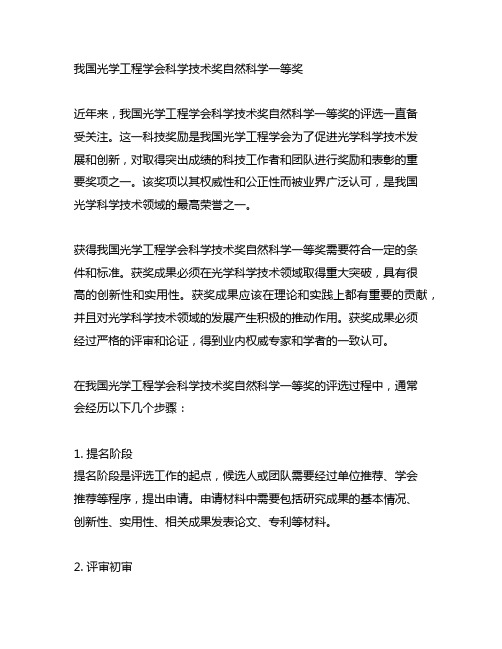
我国光学工程学会科学技术奖自然科学一等奖近年来,我国光学工程学会科学技术奖自然科学一等奖的评选一直备受关注。
这一科技奖励是我国光学工程学会为了促进光学科学技术发展和创新,对取得突出成绩的科技工作者和团队进行奖励和表彰的重要奖项之一。
该奖项以其权威性和公正性而被业界广泛认可,是我国光学科学技术领域的最高荣誉之一。
获得我国光学工程学会科学技术奖自然科学一等奖需要符合一定的条件和标准。
获奖成果必须在光学科学技术领域取得重大突破,具有很高的创新性和实用性。
获奖成果应该在理论和实践上都有重要的贡献,并且对光学科学技术领域的发展产生积极的推动作用。
获奖成果必须经过严格的评审和论证,得到业内权威专家和学者的一致认可。
在我国光学工程学会科学技术奖自然科学一等奖的评选过程中,通常会经历以下几个步骤:1. 提名阶段提名阶段是评选工作的起点,候选人或团队需要经过单位推荐、学会推荐等程序,提出申请。
申请材料中需要包括研究成果的基本情况、创新性、实用性、相关成果发表论文、专利等材料。
2. 评审初审通过初审,对提名材料进行初步评定,排除不符合条件的内容,确定符合奖项评选条件的候选人或团队。
此阶段的评审一般由组织评审专家委员会或专家小组进行。
3. 评审复审评审复审一般是在初审通过的基础上,对入围的候选人或团队的研究成果进行深入细致的评审。
这一阶段的评审将对研究成果的科学价值、技术创新、应用前景等方面进行全面评估,最终确定获奖名单。
4. 最终评定最终评定是在经过初审、复审后,对获奖名单进行最终确定和公布。
评选工作的结果将由我国光学工程学会正式公布,并对获奖者或获奖团队进行授奖。
获奖项目将在学术会议上进行颁奖,并发布相关成果。
我国光学工程学会科学技术奖自然科学一等奖的设立和评选,为我国光学科学技术领域的发展提供了良好的机制和激励措施。
通过该奖项的不断推出和评选,不仅能够激励和表彰在光学科学技术领域作出杰出成绩的科技工作者和团队,还能够促进光学领域创新技术的不断涌现和产业的快速发展。
China's Research Culture,含中文翻译
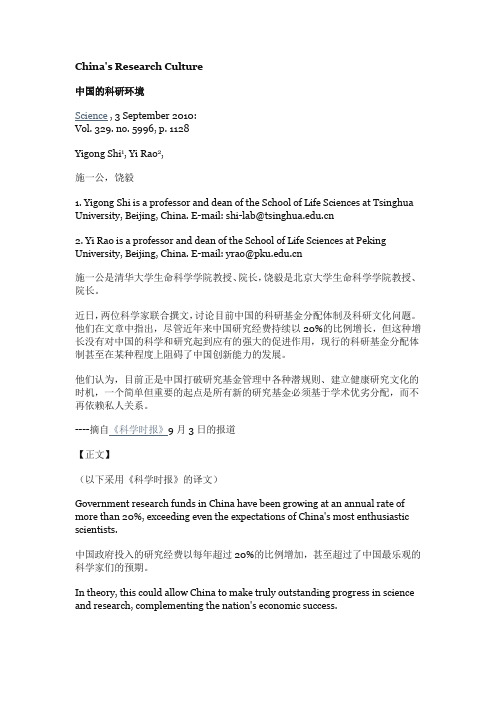
China's Research Culture中国的科研环境Science , 3 September 2010:Vol. 329. no. 5996, p. 1128Yigong Shi1, Yi Rao2,施一公,饶毅1. Yigong Shi is a professor and dean of the School of Life Sciences at Tsinghua University, Beijing, China. E-mail: shi-lab@2. Yi Rao is a professor and dean of the School of Life Sciences at Peking University, Beijing, China. E-mail: yrao@施一公是清华大学生命科学学院教授、院长,饶毅是北京大学生命科学学院教授、院长。
近日,两位科学家联合撰文,讨论目前中国的科研基金分配体制及科研文化问题。
他们在文章中指出,尽管近年来中国研究经费持续以20%的比例增长,但这种增长没有对中国的科学和研究起到应有的强大的促进作用,现行的科研基金分配体制甚至在某种程度上阻碍了中国创新能力的发展。
他们认为,目前正是中国打破研究基金管理中各种潜规则、建立健康研究文化的时机,一个简单但重要的起点是所有新的研究基金必须基于学术优劣分配,而不再依赖私人关系。
----摘自《科学时报》9月3日的报道【正文】(以下采用《科学时报》的译文)Government research funds in China have been growing at an annual rate of more than 20%, exceeding even the expectations of China's most enthusiastic scientists.中国政府投入的研究经费以每年超过20%的比例增加,甚至超过了中国最乐观的科学家们的预期。
国家自然科学基金委员会与丹麦国家研究基金会合作研究项目(摘要)

国家自然科学基金委员会与丹麦国家研究基金会合作研究项目(摘要)发布单位:基金委国际合作局西欧处主要申请条件:(详见附件2)1.申请人必须是在研的国家自然科学基金重点项目执行人、或创新研究群体项目负责人、或国家杰出青年科学基金项目获得者。
2.每个项目为期3年,中方资助强度为每项100万元人民币左右。
3.申报截止日期是每年9月1日。
申请流程:1. 在线填报中文申请书:登录https://网站填报申请表(详见附件2)。
2. 填报英文申请书“ELECTRONIC APPLICATION FORM FOR PROPOSALS FOR NANO RESEARCH COLLABORATIONS”(见附件1),并将填写完毕的英文申请书上传添加至中文申请书的“附件”栏中一同在线提交。
3. 将中、英文申请书一式两份于8月25日前交到科研处。
附件1.ELECTRONIC APPLICATION FORM FOR PROPOSALS FOR NANO RESEARCH COLLABORATIONS - under the framework of the Danish National Research Foundation International Collaboration with the National Natural Science Foundation of ChinaTo see the call for proposals, please refer to the webpage of the Danish National Research Foundation (DNRF): www.dg.dk and the National Natural Science Foundation of China (NSFC): This downloaded application form must be electronically submitted as a PDF document no later than 1 September 2008 by the Danish principal investigator to the DNRF at dg@dg.dk and correspondingly by the Chinese principal investigator to the NSFC through its ISIS system.The form is to be filled out in English with the font ”Times New Roman”, size 12, with one line space. Applicants are kindly requested to meet the following requirements as well.ObjectiveThe objective is to strengthen the competitiveness of Danish and Chinese research in nanoscience and nanotechnology through collaboration. To this end the two Foundations wish to support scientific research within new nano structures and their functions. Such initiatives might include as examples research on self assembly of (molecular) nanostructures and their functions, nanomaterials with new functional and structural properties, functional nanodevices and molecular electronics.Applications may thus include project proposals which have a translational approach ranging from basic sciences to relevant applications.Requirements∙ The applications must be made as truly joint applications written by the responsibleChinese principal investigator and the responsible Danish principal investigator so that each initiative is represented by only one application, incl. budgets specifying the Chinese and Danish respective costs. ∙ Both sides shall send scientists to the other part as well as receive visiting researchers and PhD students.∙The Danish host institution is required to provide the necessary resources, includingoffices, laboratories, equipment, etc. The institution is further expected to contribute withPhD-stipends and travel grants.Selection CriteriaWhen selecting which proposals to support, the two Foundations will emphasise (not in any order of priority):∙The scientific quality of the proposal∙The added value of performing joint collaborative research between the research groups involve∙The degree of complementarity between the involved research groups in answering the research questions addressed.EvaluationThe proposals will be reviewed by international peers (preferably neither Chinese nor Danish). The Boards of the DNRF and the NSFC will take the reviews into consideration as an important part of their decision-making process when agreeing on which joint projects to fund.After two and a half years the two parties will jointly evaluate the progress of the research initiatives. The evaluation will be based on a self-evaluation and on international peer review. The project may be extended with another 3 year grant.Further informationFor further information or if you have questions to the form or to other parts of the application process, please contact:NSFC, China: Lu Rongkai, Director of Division, Bureau of International Cooperation.E:mail: lurk@ or tel.: + 8610 – 6232 7014.DNRF, Denmark: Research Adviser Geeske de Witte V estergaard gwv@dg.dk, or tel.: + 45 – 3318 1950.1The NSFC will fund the Chinese research partner and the DNRF will fund the Danish research partner.In terms of mobility of scientists (senior scientists, post docs and PhD students) the receiving party pays for accommodation and daily allowances whereas the party sending such visitors would pay for international transportation.SIGNATURES15.Signatures of responsible principal investigator in each country, dates and places (“I assurethat the information I have presented in this application and its appendices is correct and that all the factors essential for the processing of the application have been included. I undertake the responsibility that, in the event that DNRF and NSFC grant the funding, the funds will be used for the purpose for which they have been granted and that any reports required by DNRF and NSFC will be submitted.”)Date and place:Signature:Date and place:Signature:16Signatures of the signing official of each host institution, dates, places (The host institutions stated in the present application will provide the researchers the necessary work premises, equipment and other basic research prerequisites. The host institution commits itself, in the event that DNRF and NSFC grant the funding, to undertake the responsibility for ensuring that the funds will be used for the purpose for which they are granted and to hire the personnel whose salaries are to be paid with the appropriation, and to submit in accordance with the instructions of DNRF and NSFC, reports on the use of the funds.Date and place:Signature:Date and place:Signature:附件2.关于征集2009年国家自然科学基金委员会与丹麦国家研究基金会合作研究项目的通知为推动中丹两国科学家的实质性合作,国家自然科学基金委员会(NSFC)与丹麦国家研究基金会(DNRF)拟在“新纳米结构及其功能(New Nano Structures and their Functions)”领域(详见英文申请书)共同资助两国科学家合作研究。
人事部翻译考试(二级)系列参考资料(1)
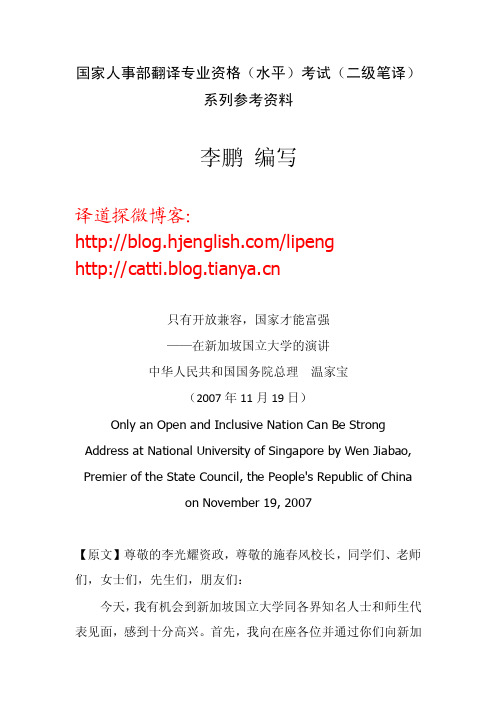
国家人事部翻译专业资格(水平)考试(二级笔译)系列参考资料李鹏编写译道探微博客:/lipeng只有开放兼容,国家才能富强——在新加坡国立大学的演讲中华人民共和国国务院总理温家宝(2007年11月19日)Only an Open and Inclusive Nation Can Be Strong Address at National University of Singapore by Wen Jiabao, Premier of the State Council, the People's Republic of Chinaon November 19, 2007【原文】尊敬的李光耀资政,尊敬的施春风校长,同学们、老师们,女士们,先生们,朋友们:今天,我有机会到新加坡国立大学同各界知名人士和师生代表见面,感到十分高兴。
首先,我向在座各位并通过你们向新加坡人民转达中国人民的诚挚问候和良好祝愿。
【译文】Minister Mentor Lee Kuan Yew,Mr. Shih Choon Fong, President of the National University of Singapore,Students and faculty members,Ladies and gentlemen,Friends,I am delighted to have this opportunity of meeting you, leading public figures in Singapore and representatives of faculty and students of the National University of Singapore (NUS). Let me begin by conveying the warm greetings and best wishes of the Chinese people to you, and through you, to the people of Singapore.【评点】1.第二部分值得背诵,口译和笔译工作中都能用得上。
民族药理学作者须知
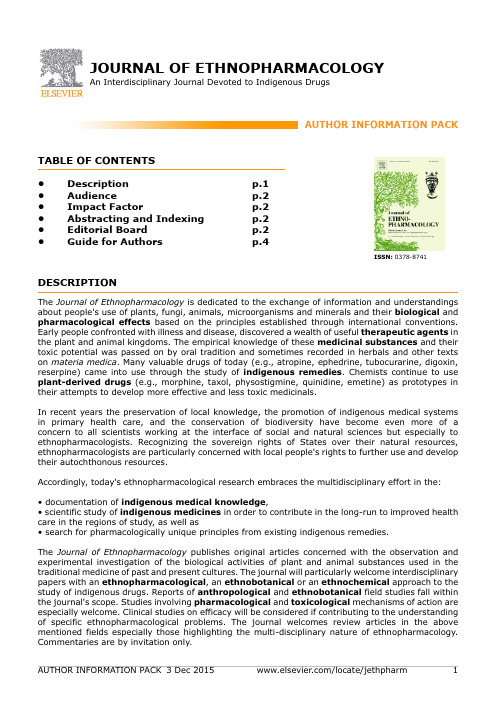
JOURNAL OF ETHNOPHARMACOLOGYAn Interdisciplinary Journal Devoted to Indigenous DrugsAUTHOR INFORMATION PACK TABLE OF CONTENTS• Description• Audience• Impact Factor• Abstracting and Indexing • Editorial Board• Guide for Authors p.1p.2p.2p.2p.2p.4ISSN: 0378-8741DESCRIPTIONThe Journal of Ethnopharmacology is dedicated to the exchange of information and understandings about people's use of plants, fungi, animals, microorganisms and minerals and their biological and pharmacological effects based on the principles established through international conventions. Early people confronted with illness and disease, discovered a wealth of useful therapeutic agents in the plant and animal kingdoms. The empirical knowledge of these medicinal substances and their toxic potential was passed on by oral tradition and sometimes recorded in herbals and other texts on materia medica. Many valuable drugs of today (e.g., atropine, ephedrine, tubocurarine, digoxin, reserpine) came into use through the study of indigenous remedies. Chemists continue to use plant-derived drugs (e.g., morphine, taxol, physostigmine, quinidine, emetine) as prototypes in their attempts to develop more effective and less toxic medicinals.In recent years the preservation of local knowledge, the promotion of indigenous medical systems in primary health care, and the conservation of biodiversity have become even more of a concern to all scientists working at the interface of social and natural sciences but especially to ethnopharmacologists. Recognizing the sovereign rights of States over their natural resources, ethnopharmacologists are particularly concerned with local people's rights to further use and develop their autochthonous resources.Accordingly, today's ethnopharmacological research embraces the multidisciplinary effort in the:• documentation of indigenous medical knowledge,• scientific study of indigenous medicines in order to contribute in the long-run to improved health care in the regions of study, as well as• search for pharmacologically unique principles from existing indigenous remedies.The Journal of Ethnopharmacology publishes original articles concerned with the observation and experimental investigation of the biological activities of plant and animal substances used in the traditional medicine of past and present cultures. The journal will particularly welcome interdisciplinary papers with an ethnopharmacological, an ethnobotanical or an ethnochemical approach to the study of indigenous drugs. Reports of anthropological and ethnobotanical field studies fall within the journal's scope. Studies involving pharmacological and toxicological mechanisms of action are especially welcome. Clinical studies on efficacy will be considered if contributing to the understanding of specific ethnopharmacological problems. The journal welcomes review articles in the above mentioned fields especially those highlighting the multi-disciplinary nature of ethnopharmacology. Commentaries are by invitation only.AUDIENCEEthnopharmacologists, Medicinal Chemists, Pharmacologists, Toxicologists, Anthropologists, Pharmacognosists, Ethnobotanists, Economic Botanists, EthnobiologistsIMPACT FACTOR2014: 2.998 © Thomson Reuters Journal Citation Reports 2015ABSTRACTING AND INDEXINGAGRICOLABIOSISCambridge Scientific AbstractsChemical AbstractsCurrent Contents/Life SciencesMEDLINE®International Pharmaceutical AbstractsEMBASENAPRALERT (Natural Products Alert)Science Citation IndexCAB AbstractsScopusEMBiologyEDITORIAL BOARDEditor-in-Chief:R. Verpoorte, Gorlaeus Lab., Universiteit Leiden, Einsteinweg 55, 2333 CC, Leiden, NetherlandsDeputy Editor-in-ChiefA.M. Viljoen, Tshwane University of Technology, Pretoria, South AfricaAssociate Editor:D. Guo, Chinese Academy of Sciences (CAS), Shanghai, ChinaA.K. Jäger, University of Copenhagen, Copenhagen O, DenmarkG. Lin, Chinese University of Hong Kong, Hong Kong, Hong KongP.K. Mukherjee, Jadavpur University, Kolkata, IndiaG. Schmeda Hirschmann, Universidad de Talca, Talca, ChileA. Shikov, Saint Petersburg Institute of Pharmacy, Kuzmolovo P 245, Russian FederationE. Yesilada, Yeditepe University, Erenkoy-Istanbul, TurkeyReviews Editor (including Commentaries and Book Reviews):M. Heinrich, The School of Pharmacy, University of London, 29-39 Brunswick Square, London, WC1N 1AX, UK If you want to suggest a review, please provide a structured abstract and include an annotated table of contents and a short CV of the lead author(s).Managing Editor:B. Pomahacova, Leiden University, Leiden, NetherlandsI. Vermaak, Tshwane University of Technology, Pretoria, South AfricaM. Sandasi, Tshwane University of Technology, Pretoria, South AfricaL.J. McGaw, University of Pretoria, Pretoria, South AfricaEditorial Board:S. Alban, Kiel, GermanyM.J. Balick, Bronx, New York, USAR. BauerG. Bourdy, Cayenne, French GuianaJ.B. Calixto, Florianópolis, BrazilC-T. Che, Hong Kong, Hong KongG.A. Cordell, Evanston, Illinois, USAV.S. da Silva Bolzani, Araraquara, BrazilJ. Ding, Shanghai, ChinaV.M. Dirsch, Vienna, AustriaE. Elisabetsky, Porto Alegre, BrazilJ. Fleurentin, Metz, FranceB.L. Furman, Glasgow, UKM.P. Germano, Messina, ItalyJ. Gertsch, Bern, SwitzerlandA.H. Gilani, Karachi, PakistanM.P. Gupta, Panama City, PanamaA. Hensel, Münster, GermanyP.J. Houghton, London, UKZ. Ismail, Penang, MalaysiaW. Jia, Kannapolis, North Carolina, USAT. Johns, Ste. Anne de Bellevue, Quebec, Canada A.K. Jäger, Copenhagen O, DenmarkG. Kavalali, Istanbul, TurkeyH-S. Kim, Cheongju, South KoreaJ. Kim, Seoul, South KoreaY. Kimura, Ehime, JapanM.A. Lacaille-Dubois, Dijon, FranceM. Leonti, Cagliari, ItalyE. Matteucci, Pisa, ItalyI. Merfort, Freiburg, GermanyJ.J.M. Meyer, Pretoria, South AfricaD.E. MoermanD.A. Mulholland, Guildford, England, UKA. Panthong, Chiang Mai, ThailandX. Peigen, Beijing, ChinaA. Pieroni, Pollenzo/Bra, ItalyD.D. Soejarto, Chicago, Illinois, USAE. Speroni, Bologna, ItalyA.J. Vlietinck, Antwerpen, BelgiumH. Wagner, München, GermanyC.S. Weckerle, Zurich, SwitzerlandC.W. Wright, Bradford, UKS. Zacchino, Rosario, ArgentinaFounding Editors:J.G. BruhnL. Rivier, Lausanne, SwitzerlandGUIDE FOR AUTHORSINTRODUCTIONThe Journal of Ethnopharmacology is dedicated to the exchange of information and understandings about people's use of plants, fungi, animals, microorganisms and minerals and their biological and pharmacological effects based on the principles established through international conventions. Early people, confronted with illness and disease, discovered a wealth of useful therapeutic agents in the plant and animal kingdoms. The empirical knowledge of these medicinal substances and their toxic potential was passed on by oral tradition and sometimes recorded in herbals and other texts on materia medica. Many valuable drugs of today (e.g., atropine, ephedrine, tubocurarine, digoxin, reserpine) came into use through the study of indigenous remedies. Chemists continue to use plant-derived drugs (e.g., morphine, taxol, physostigmine, quinidine, emetine) as prototypes in their attempts to develop more effective and less toxic medicinals.Please note that figures and tables should be embedded in the text as close as possible to where they are initially cited. It is also mandatory to upload separate graphic and table files as these will be required if your manuscript is accepted for publication.Classification of your paperPlease note that upon submitting your article you will have to select at least one classification and at least three of the given keywords. You can preview the list of classifications and keywords (here). This information is needed by the Editors to more quickly process your article. In addition to this, you can submit free keywords as described below under "Keywords".The "rules of 5"The Editors and Editorial Board have developed the "Rules of 5" for publishing in JEP. We have produced five clear criteria that each author needs to think about before submitting a manuscript and setting the whole process of editing and reviewing at work. Click here.For more details on how to write a world class paper, please visit our Pharmacology Author Resources page.Authors are encouraged to submit video material or animation sequences to support and enhance your scientific research. For more information please see the paragraph on video data below. Types of paperThe Journal of Ethnopharmacology will accept the following contributions:1. Original research articles - whose length is not limited and should include Title, Abstract, Methods and Materials, Results, Discussion, Conclusions, Acknowledgements and References. As a guideline, a full length paper normally occupies no more than 10 printed pages of the journal, including tables and illustrations.2. Short Communications - whose average length is not more than 4 pages in print (approx. 2000-2300 words, including abstract and references). A maximum of 2 illustrations (figures or tables) is allowed. See paragraph below for description and format.3. Letters to the Editors.4. Reviews - Authors intending to write review articles should consult and send an outline to the Reviews Editor (see inside front cover for contact information) before preparing their manuscripts. The organization and subdivision of review articles can be arranged at the author's discretion. Authors should keep in mind that a good review sets the trend and direction of future research on the subject matter being reviewed. Tables, figures and references are to be arranged in the same way as research articles in the journal. Reviews on topics that address cutting-edge problems are particularly welcome. Outlines for potential reviews need to include: A detailed abstract using the structure provided in the guidelines An annotated table of contents A short CV of the lead author5. Book reviews - Books for review should be sent to the Reviews Editor.6. Commentaries - invited, peer-reviewed, critical discussion about crucial aspects of the field but most importantly methodological and conceptual-theoretical developments in the field and should also provide a standard, for example, for pharmacological methods to be used in papers in the Journal of Ethnopharmacology. The scientific dialogue differs greatly in the social / cultural and natural sciences, the discussions about the common foundations of the field are ongoing and thepapers published should contribute to a transdisciplinary and multidisciplinary discussion. The length should be a maximum of 2-3 printed pages or 2500 words. Please contact the Reviews Editor j.ethnopharmacol@ with an outline.7. Conference announcements and news.BEFORE YOU BEGINEthics in publishingFor information on Ethics in publishing and Ethical guidelines for journal publication see /publishingethics and /journal-authors/ethics. Policy and ethicsIn the covering letter, the author must also declare that the study was performed according to the international, national and institutional rules considering animal experiments, clinical studies and biodiversity rights. See below for further information. The ethnopharmacological importance of the study must also be explained in the cover letter.Animal and clinical studies - Investigations using experimental animals must state in the Methods section that the research was conducted in accordance with the internationally accepted principles for laboratory animal use and care as found in for example the European Community guidelines (EEC Directive of 1986; 86/609/EEC) or the US guidelines (NIH publication #85-23, revised in 1985). Investigations with human subjects must state in the Methods section that the research followed guidelines of the Declaration of Helsinki and Tokyo for humans, and was approved by the institutional human experimentation committee or equivalent, and that informed consent was obtained. The Editors will reject papers if there is any doubt about the suitability of the animal or human procedures used.Biodiversity rights - Each country has its own rights on its biodiversity. Consequently for studying plants one needs to follow the international, national and institutional rules concerning the biodiversity rights.Author contributionsFor each author the contribution to the publication should be mentioned.Conflict of interestAll authors are requested to disclose any actual or potential conflict of interest including any financial, personal or other relationships with other people or organizations within three years of beginning the submitted work that could inappropriately influence, or be perceived to influence, their work. See also /conflictsofinterest. Further information and an example of a Conflict of Interest form can be found at: /app/answers/detail/a_id/286/supporthub/publishing.Submission declaration and verificationSubmission of an article implies that the work described has not been published previously (except in the form of an abstract or as part of a published lecture or academic thesis or as an electronic preprint, see /sharingpolicy), that it is not under consideration for publication elsewhere, that its publication is approved by all authors and tacitly or explicitly by the responsible authorities where the work was carried out, and that, if accepted, it will not be published elsewhere in the same form, in English or in any other language, including electronically without the written consent of the copyright-holder. To verify originality, your article may be checked by the originality detection service CrossCheck /editors/plagdetect.Changes to authorshipAuthors are expected to consider carefully the list and order of authors before submitting their manuscript and provide the definitive list of authors at the time of the original submission. Any addition, deletion or rearrangement of author names in the authorship list should be made only before the manuscript has been accepted and only if approved by the journal Editor. To request such a change, the Editor must receive the following from the corresponding author: (a) the reason for the change in author list and (b) written confirmation (e-mail, letter) from all authors that they agree with the addition, removal or rearrangement. In the case of addition or removal of authors, this includes confirmation from the author being added or removed.Only in exceptional circumstances will the Editor consider the addition, deletion or rearrangement of authors after the manuscript has been accepted. While the Editor considers the request, publication of the manuscript will be suspended. If the manuscript has already been published in an online issue, any requests approved by the Editor will result in a corrigendum.Article transfer serviceThis journal is part of our Article Transfer Service. This means that if the Editor feels your article is more suitable in one of our other participating journals, then you may be asked to consider transferring the article to one of those. If you agree, your article will be transferred automatically on your behalf with no need to reformat. Please note that your article will be reviewed again by the new journal. More information about this can be found here: /authors/article-transfer-service. CopyrightUpon acceptance of an article, authors will be asked to complete a 'Journal Publishing Agreement' (for more information on this and copyright, see /copyright). An e-mail will be sent to the corresponding author confirming receipt of the manuscript together with a 'Journal Publishing Agreement' form or a link to the online version of this agreement.Subscribers may reproduce tables of contents or prepare lists of articles including abstracts for internal circulation within their institutions. Permission of the Publisher is required for resale or distribution outside the institution and for all other derivative works, including compilations and translations (please consult /permissions). If excerpts from other copyrighted works are included, the author(s) must obtain written permission from the copyright owners and credit the source(s) in the article. Elsevier has preprinted forms for use by authors in these cases: please consult /permissions.For open access articles: Upon acceptance of an article, authors will be asked to complete an 'Exclusive License Agreement' (for more information see /OAauthoragreement). Permitted third party reuse of open access articles is determined by the author's choice of user license (see /openaccesslicenses).Author rightsAs an author you (or your employer or institution) have certain rights to reuse your work. For more information see /copyright.Role of the funding sourceYou are requested to identify who provided financial support for the conduct of the research and/or preparation of the article and to briefly describe the role of the sponsor(s), if any, in study design; in the collection, analysis and interpretation of data; in the writing of the report; and in the decision to submit the article for publication. If the funding source(s) had no such involvement then this should be stated.Funding body agreements and policiesElsevier has established a number of agreements with funding bodies which allow authors to comply with their funder's open access policies. Some authors may also be reimbursed for associated publication fees. To learn more about existing agreements please visit /fundingbodies.Open accessThis journal offers authors a choice in publishing their research:Open access• Articles are freely available to both subscribers and the wider public with permitted reuse• An open access publication fee is payable by authors or on their behalf e.g. by their research funder or institutionSubscription• Articles are made available to subscribers as well as developing countries and patient groups through our universal access programs (/access).• No open access publication fee payable by authors.Regardless of how you choose to publish your article, the journal will apply the same peer review criteria and acceptance standards.For open access articles, permitted third party (re)use is defined by the following Creative Commons user licenses:Creative Commons Attribution (CC BY)Lets others distribute and copy the article, create extracts, abstracts, and other revised versions, adaptations or derivative works of or from an article (such as a translation), include in a collective work (such as an anthology), text or data mine the article, even for commercial purposes, as long as they credit the author(s), do not represent the author as endorsing their adaptation of the article, and do not modify the article in such a way as to damage the author's honor or reputation. Creative Commons Attribution-NonCommercial-NoDerivs (CC BY-NC-ND)For non-commercial purposes, lets others distribute and copy the article, and to include in a collective work (such as an anthology), as long as they credit the author(s) and provided they do not alter or modify the article.The open access publication fee for this journal is USD 3250, excluding taxes. Learn more about Elsevier's pricing policy: /openaccesspricing.Green open accessAuthors can share their research in a variety of different ways and Elsevier has a number of green open access options available. We recommend authors see our green open access page for further information (/greenopenaccess). Authors can also self-archive their manuscripts immediately and enable public access from their institution's repository after an embargo period. This is the version that has been accepted for publication and which typically includes author-incorporated changes suggested during submission, peer review and in editor-author communications. Embargo period: For subscription articles, an appropriate amount of time is needed for journals to deliver value to subscribing customers before an article becomes freely available to the public. This is the embargo period and it begins from the date the article is formally published online in its final and fully citable form.This journal has an embargo period of 12 months.Language (usage and editing services)Please write your text in good English (American or British usage is accepted, but not a mixture of these). Authors who feel their English language manuscript may require editing to eliminate possible grammatical or spelling errors and to conform to correct scientific English may wish to use the English Language Editing service available from Elsevier's WebShop (/languageediting/) or visit our customer support site () for more information.SubmissionOur online submission system guides you stepwise through the process of entering your article details and uploading your files. The system converts your article files to a single PDF file used in the peer-review process. Editable files (e.g., Word, LaTeX) are required to typeset your article for final publication. All correspondence, including notification of the Editor's decision and requests for revision, is sent by e-mail.Additional informationAuthors who want to submit a manuscript should consult and peruse carefully recent issues of the journal for format and style. Authors must include the following contact details on the title page of their submitted manuscript: full postal address; fax; e-mail. All manuscripts submitted are subject to peer review. The minimum requirements for a manuscript to qualify for peer review are that it has been prepared by strictly following the format and style of the journal as mentioned, that it is written in good English, and that it is complete. Manuscripts that have not fulfilled these requirements will be returned to the author(s).In addition, you are recommended to adhere to the research standards described in the following articles:Cos P., Vlietinck A.J., Berghe D.V., et al. (2006) Anti-infective potential of natural products: how to develop a stronger in vitro 'proof-of-concept'. Journal of Ethnopharmacology, 106: 290-302.Matteucci, E., Giampietro, O. (2008) Proposal open for discussion: defining agreed diagnostic procedures in experimental diabetes research. Journal of Ethnopharmacology,115: 163-172.Froede, T.SA. and Y.S. Medeiros, Y.S. (2008) Animal models to test drugs with potential antidiabetic activity. Journal of Ethnopharmacology 115: 173-183. Gertsch J. (2009) How scientific is the science in ethnopharmacology? Historical perspectives and epistemological problems. Journal of Ethnopharmacology, 122: 177-183.Chan K., et al. (2012) Good practice in reviewing and publishing studies on herbal medicine, with special emphasis on traditional Chinese medicine and Chinese Materia Medica. Journal of Ethnopharmacology 140: 469-475.Heinrich, M., Edwards. S., Moerman. D.E.. and Leonti. M. (2009), Ethnopharmacological field studies: a critical assessment of their conceptual basis and methods. J. Ethnopharmacol, 124: 1-17. PREPARATIONUse of word processing softwareIt is important that the file be saved in the native format of the word processor used. The text should be in single-column format. Keep the layout of the text as simple as possible. Most formatting codes will be removed and replaced on processing the article. In particular, do not use the word processor's options to justify text or to hyphenate words. However, do use bold face, italics, subscripts, superscripts etc. When preparing tables, if you are using a table grid, use only one grid for each individual table and not a grid for each row. If no grid is used, use tabs, not spaces, to align columns. The electronic text should be prepared in a way very similar to that of conventional manuscripts (see also the Guide to Publishing with Elsevier: /guidepublication). Note that source files of figures, tables and text graphics will be required whether or not you embed your figures in the text. See also the section on Electronic artwork.To avoid unnecessary errors you are strongly advised to use the 'spell-check' and 'grammar-check' functions of your word processor.Article structureSubdivision - numbered sectionsDivide your article into clearly defined and numbered sections. Subsections should be numbered 1.1 (then 1.1.1, 1.1.2, ...), 1.2, etc. (the abstract is not included in section numbering). Use this numbering also for internal cross-referencing: do not just refer to 'the text'. Any subsection may be given a brief heading. Each heading should appear on its own separate line.IntroductionState the objectives of the work and provide an adequate background, avoiding a detailed literature survey or a summary of the results.Material and methodsProvide sufficient detail to allow the work to be reproduced. Methods already published should be indicated by a reference: only relevant modifications should be described.Theory/calculationA Theory section should extend, not repeat, the background to the article already dealt with in the Introduction and lay the foundation for further work. In contrast, a Calculation section represents a practical development from a theoretical basis.ResultsResults should be clear and concise.DiscussionThis should explore the significance of the results of the work, not repeat them. A combined Results and Discussion section is often appropriate. Avoid extensive citations and discussion of published literature.ConclusionsThe main conclusions of the study may be presented in a short Conclusions section, which may stand alone or form a subsection of a Discussion or Results and Discussion section.GlossaryPlease supply, as a separate list, the definitions of field-specific terms used in your article.AppendicesIf there is more than one appendix, they should be identified as A, B, etc. Formulae and equations in appendices should be given separate numbering: Eq. (A.1), Eq. (A.2), etc.; in a subsequent appendix, Eq. (B.1) and so on. Similarly for tables and figures: Table A.1; Fig. A.1, etc.Essential title page information• Title.Concise and informative. Titles are often used in information-retrieval systems. Avoid abbreviations and formulae where possible.• Author names and affiliations. Please clearly indicate the given name(s) and family name(s) of each author and check that all names are accurately spelled. Present the authors' affiliation addresses (where the actual work was done) below the names. Indicate all affiliations with a lower-case superscript letter immediately after the author's name and in front of the appropriate address. Provide the full postal address of each affiliation, including the country name and, if available, the e-mail address of each author.• Corresponding author. Clearly indicate who will handle correspondence at all stages of refereeing and publication, also post-publication. Ensure that the e-mail address is given and that contact details are kept up to date by the corresponding author.• Present/permanent address. If an author has moved since the work described in the article was done, or was visiting at the time, a 'Present address' (or 'Permanent address') may be indicated as a footnote to that author's name. The address at which the author actually did the work must be retained as the main, affiliation address. Superscript Arabic numerals are used for such footnotes. AbstractA concise and factual abstract is required. The abstract should state briefly the purpose of the research, the principal results and major conclusions. An abstract is often presented separately from the article, so it must be able to stand alone. For this reason, References should be avoided, but if essential, then cite the author(s) and year(s). Also, non-standard or uncommon abbreviations should be avoided, but if essential they must be defined at their first mention in the abstract itself.The author should divide the abstract with the headings Ethnopharmacological relevance, Aim of the study , Materials and Methods, Results, and Conclusions.Click here to see an example.Graphical abstractA Graphical abstract is mandatory for this journal. It should summarize the contents of the article in a concise, pictorial form designed to capture the attention of a wide readership online. Authors must provide images that clearly represent the work described in the article. Graphical abstracts should be submitted as a separate file in the online submission system. Image size: please provide an image with a minimum of 531 × 1328 pixels (h × w) or proportionally more. The image should be readable at a size of 5 × 13 cm using a regular screen resolution of 96 dpi. Preferred file types: TIFF, EPS, PDF or MS Office files. See /graphicalabstracts for examples.Authors can make use of Elsevier's Illustration and Enhancement service to ensure the best presentation of their images also in accordance with all technical requirements: Illustration Service. KeywordsAfter having selected a classification in the submission system, authors must in the same step select 5 keywords. These keywords will help the Editors to categorize your article accurately and process it more quickly. A list of the classifications and set keywords can be found here.In addition, you can provide a maximum of 6 specific keywords, using American spelling and avoiding general and plural terms and multiple concepts (avoid, for example, "and", "of"). Be sparing with abbreviations: only abbreviations firmly established in the field may be eligible. These keywords will be used for indexing purposes.Chemical compoundsYou can enrich your article by providing a list of chemical compounds studied in the article. The list of compounds will be used to extract relevant information from the NCBI PubChem Compound database and display it next to the online version of the article on ScienceDirect. You can include up to 10 names of chemical compounds in the article. For each compound, please provide the PubChem CID of the most relevant record as in the following example: Glutamic acid (PubChem CID:611). The PubChem CIDs can be found via /pccompound. Please position the list of compounds immediately below the 'Keywords' section. It is strongly recommended to follow the exact text formatting as in the example below:。
2020-2021学年高中英语人教(2019)版必修三Unit 1 学案

Unit 1 Festivals and CelebrationsReading for WritingWrite about your festival experience课型:新授课课时:2课时班级:______姓名:________小组:_______【学习目标】Teaching Objectives:1. To read for specific information and understand words in text.2. To know about Tu Youyou and her achievement.3. To learn from the virtues of scientific spirits from the example of Tu Youyou and her team.Teaching Important Points:To get students know about the features of news report , master the method to describe figures’ experience in the order of time and explore the reasons of Tu Youyou’s success .Teaching Difficulties:To figure out the real meaning of a man of success, to direct students to acknowledge themselves, reflect themselves and make their career schedules of life.Ⅰ.了解感知Try to become not a man of success, but try rather to become a man of value.——Albert Einstein_______________________________________________________________ _________________Ⅱ.深入学习Step 1Who is the woman in the photo?What is happening in this photo?Task 1Reading: TU YOUYOU AW ARDED NOBEL PRIZE Circle the answers to the questions below.1. Where would you most likely find this passage?A. In a blog.B. In a book.C. In a letter.D. In a newspaper.2. Passages like this are most often written in _______ and _______.A the active voice/ offer many opinionsB the first person/ talk about feelingsC both active and passive voices/ mostly contain facts3. Which two pieces of information were not included in the passage?A. A quote from Tu Youyou.B The details of how artemisinin was discovered.C Tu Youyou's important contributions other than the discovery of artemisinin.D Tu Youyou's personal lifeE Tu Youyou's road to discovering artemisinin.F What Tu Youyou was awarded.G Why artemisinin is an important discovery.Task 2Match the main ideas with each paragraph.Para1: Tu Youyou and her team how to draw out sweet wormwood extract.Para2: Tu Youyou decided to review ancient Chinese medical textsto find traditional botanical treatments for malaria. Para3: Tu Youyou said the discovery of artemisnin was a team effort.Para4: Tu Youyou awarded Nobel Prize3 fillin theblanksCareful – readingTask 1Why is the discovery of artemisinin important?_______________________________________________________________ __________Can you list the exact number?_______________________________________________________________ __________Task2Read for data: (Paras. 2-3)What qualities do the research team possess according to the data?Her team examined over_____ old medical texts, and evaluated _______ plants for their medical properties. From their research, they discovered and tested _____ distinct ancient Chinese medical treatments that showed promise in the fight against malaria.After failed more than_____times, the team finally succeeded in 1971.Task3Complete the flow chart. Then tell the story of how artemisinin was discovered.1.Tu Youyou's team examined ________________________ and evaluated ____________________________________.2.They found a medical text suggesting ______________________________________________________.3.They tested ______________________________________________________________.4.They tried _______________________________________________________________ _____________, but ______________________.5.They used a ___________________________ sweet wormwood extract.6.They tested the ______________________ to see if safe.Ⅲ.迁移应用1.Why could Tu Youyou achieve great success?2. Which is more important for making a great discovery,talent or effort?3. Write a biography (个人简介) about Tu YouyouSAMPLE:A biography (个人简介) about Tu YouyouTu Youyou was awarded the Nobel Prize in 2015 for her research, _____ led to the discovery of artemisinin. Artemisinin ______(save) a large number of lives since it was discovered. After _______(graduate) from university, Tu Youyou worked at the China Academy of Traditional Chinese Medicine. In 1967, Tu Youyou _______(choose) as a researcher of a team of scientists with ________ purpose of discovering a new treatment for malaria.They________(evaluate) 280.000 plants and tested 380 distinct ancient Chinese medical______(treat). One medical text suggested using the extract from sweet wormwood to treat a fever. Tu Youyou analyzed the medical texts again, and __ chance, she found one sentence suggesting a different way. Soon she found a substance that worked by_____(boil) the sweet wormwood at a lower temperature. The team's hard work _______(event) paid off in 1971.Tu Youyou thought the discovery of artemisinin was a team effort and the Nobel Prize was an honor for China's scientific research andChinese medicine to be spread around the world.Ⅳ.课后思考How do you understand the proverb “Try to become not a man of success, but try rather to become a man of value”? Explain it according to Tu Youyou’s story.。
XX2122中国驻英国大使刘晓明在亚洲商业领袖峰会午宴上的演讲
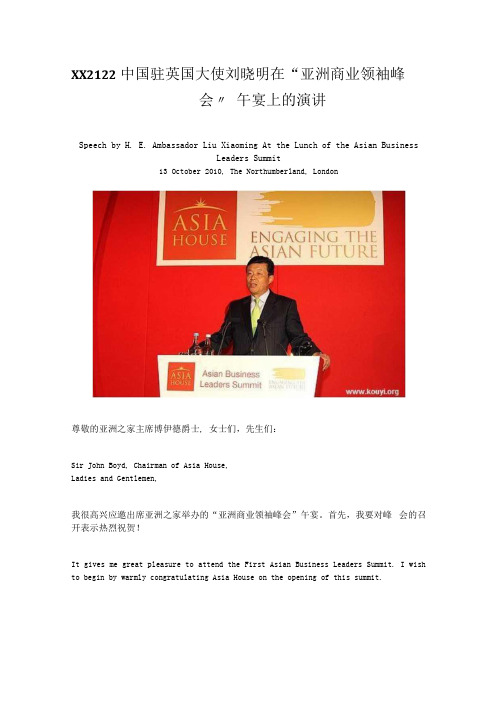
XX2122中国驻英国大使刘晓明在“亚洲商业领袖峰会〃午宴上的演讲Speech by H. E. Ambassador Liu Xiaoming At the Lunch of the Asian BusinessLeaders Summit13 October 2010, The Northumberland, London尊敬的亚洲之家主席博伊德爵士, 女士们,先生们:Sir John Boyd, Chairman of Asia House,Ladies and Gentlemen,我很高兴应邀出席亚洲之家举办的“亚洲商业领袖峰会”午宴。
首先,我要对峰会的召开表示热烈祝贺!It gives me great pleasure to attend the First Asian Business Leaders Summit. I wish to begin by warmly congratulating Asia House on the opening of this summit.中国有一句古诗,叫“东边日出西边雨”,这本是形容天气阴晴不定,但假如用它来形容当前的世界经济大概非常贴切。
美、欧经济受金融危机的深层次影响,如同伦敦的冬季,“阴雨连绵”。
相比之下,亚洲经济充满“阳光”,保持良好增长势头。
国际货币基金组织10月6日新发表的《世界经济展望》认为,明年亚洲经济整体增幅可能为6. 7%,虽较今年的7. 9%有所放缓,但亚洲“仍是全球增长最快的地区”。
As an ancient Chinese saying goes, 〃It is sunny in the east while rainy in the west. 〃This may well serve as a summary of the current global economy, with the American and European economies are still just in the rainy season, as the result of the financial crisis, whereas the Asian economy is in the summer sun with robust growth. The latest IMF World Economic Outlook estimated that the Asian economy will grow by 6. 7% in 2011. This will be lower than this year, s 7. 9% but still is enough to make it the fastest growing region.过去十年里,中国一直是亚洲经济增长最快的经济体。
sci重复率的英文表达

sci重复率的英文表达The English expression for "sci重复率" is "repetitionrate of scientific literature". It refers to the frequency at which scientific articles or studies are published repeatedly by the same authors or in the same journals within a specific timeframe.Here are 22 bilingual example sentences:1.这个研究领域的重复率极高,同一篇论文被多次发表,缺乏进一步的研究创新。
The repetition rate in this research field is alarmingly high, with the same paper published multiple times, lacking further research innovation.2.这个期刊的重复率很低,每篇发表的论文都是全新的研究成果。
The repetition rate of this journal is very low, witheach published paper being a completely new research finding.3.良好的研究伦理准则对于降低科学文献的重复率至关重要。
Good research ethics guidelines are crucial in reducing the repetition rate in scientific literature.4.重复率高又不注明引用来源的行为将被视为学术不端行为。
High repetition rates without indicating the source of citation will be considered as academic misconduct.5.多次研究表明,高重复率在科学研究中造成了信息过载和资源的浪费。
Unit 2 课文复习+群文阅读导学案-2024届高三英语一轮复习外研版(2019)必修第三册
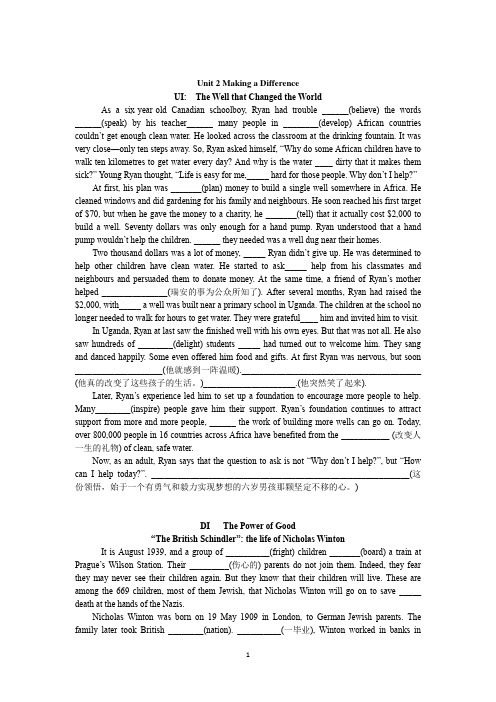
Unit 2 Making a DifferenceUI: The Well that Changed the WorldAs a six-year-old Canadian schoolboy, Ryan had trouble ______(believe) the words ______(speak) by his teacher______ many people in ________(develop) African countries couldn’t get enough clean water. He looked across the classroom at the drinking fountain. It was very close—only ten steps away. So, Ryan asked himself, “Why do some African children have to walk ten kilometres to get water every day? And why is the water ____ dirty that it makes them sick?” Young Ryan thought, “Life is easy for me,_____ hard for those people. Why don’t I help?”At first, his plan was _______(plan) money to build a single well somewhere in Africa. He cleaned windows and did gardening for his family and neighbours. He soon reached his first target of $70, but when he gave the money to a charity, he _______(tell) that it actually cost $2,000 to build a well. Seventy dollars was only enough for a hand pump. Ryan understood that a hand pump wouldn’t help the children. ______ they needed was a well dug near their homes.Two thousand dollars was a lot of money, _____ Ryan didn’t give up. He was determined to help other children have clean water. He started to ask_____ help from his classmates and neighbours and persuaded them to donate money. At the same time, a friend of Ryan’s mother helped _______________(瑞安的事为公众所知了). After several months, Ryan had raised the $2,000, with_____ a well was built near a primary school in Uganda. The children at the school no longer needed to walk for hours to get water. They were grateful____ him and invited him to visit.In Uganda, Ryan at last saw the finished well with his own eyes. But that was not all. He also saw hundreds of ________(delight) students _____ had turned out to welcome him. They sang and danced happily. Some even offered him food and gifts. At first Ryan was nervous, but soon ____________________(他就感到一阵温暖)._________________________________________ (他真的改变了这些孩子的生活。
依据“创新”的多种表达法
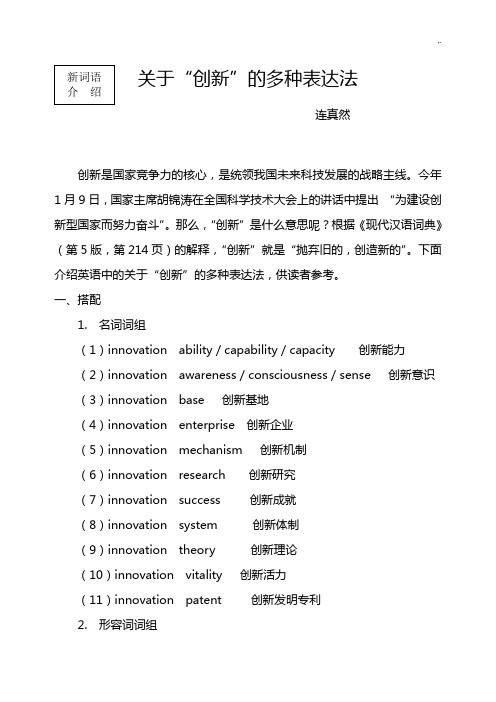
连真然创新是国家竞争力的核心,是统领我国未来科技发展的战略主线。
今年1月9日,国家主席胡锦涛在全国科学技术大会上的讲话中提出“为建设创新型国家而努力奋斗”。
那么,“创新”是什么意思呢?根据《现代汉语词典》(第5版,第214页)的解释,“创新”就是“抛弃旧的,创造新的”。
下面介绍英语中的关于“创新”的多种表达法,供读者参考。
一、搭配1. 名词词组(1)innovation ability / capability / capacity 创新能力(2)innovation awareness / consciousness / sense 创新意识(3)innovation base 创新基地(4)innovation enterprise 创新企业(5)innovation mechanism 创新机制(6)innovation research 创新研究(7)innovation success 创新成就(8)innovation system 创新体制(9)innovation theory 创新理论(10)innovation vitality 创新活力(11)innovation patent 创新发明专利2. 形容词词组(1)a creative / initiative / innovative / pioneering spirit 创新精神(2)a creative artist 富有创新精神的艺术家(3)a creative designer 富有创新精神的设计师(4)a creative mind 创新头脑(5)a creative programmer 富有创新精神的程序设计员(6)a creative solution 创新的解决办法(7)a daring innovation 大胆创新(8)a welcome innovation 可喜的创新(9)an innovation-oriented city 创新型城市(10)an innovation-oriented country 创新型国家(11)an innovation-oriented enterprise 创新型企业(12)an innovative enterpriser 富有创新精神的企业家(13)an innovative learning habit 创新学习习惯(14)an innovative mechanism 创新机制(15)an original poet 富有创新精神的诗人(16)an original painter 富有创新精神的画家(17)an original writer 富有创新精神的作家(18)creative abilities 创新能力(19)creative engineering 创新工程学,创造性工程学(20)creative learning 创新学习,创造性学习(21)creative talents 创新人才(22)creative thinking 创新思维,创造性思维(23)cultural innovation 文化创新(24)educational innovation 教育创新(25)innovation-oriented laws 创新型法律(26)innovation-oriented regulations 创新型法规;创新型规章(27)innovation-oriented scientific and technological plans 创新型科技规划(28)innovative achievements 创新成果(29)innovative business / enterprise 创新企业(30)innovative awareness / consciousness / sense 创新意识(31)innovative design 创新设计(32)innovative education 创新教育(33)innovative ideas 创新思想,富有创新精神的观念(34)innovative learning 创新学习(35)innovative products 创新产品,新产品(36)innovative technology 创新技术(37)innovative theory 创新理论(38)innovative thinking 创新思维(39)innovative undertaking 创新事业(40)institutional innovation 制度创新(41)original creation 创新,原始创新(42)pioneering techniques 创新技术;创新工艺(43)product-adding innovation 增加产品的创新(44)product-replacing innovation 置换产品的创新(45)scientific and technological innovation 科技创新(46)theoretical innovation 理论创新3. 介词词组(1)a vitally important innovation in industry工业上一项具有重大意义的创新(2)an important innovation in publishing 出版业上一项重大的创新(3)the capability of innovation 创新能力(4)the efficiency of innovation 创新效率(5)the innovation of air travel during this century 本世纪航空旅行的创新(6)the innovation vitality of the entire society全社会的创新活力(7)the key of scientific innovation 科学创新的关键(8)innovation in culture 文化创新(9)innovation in education 教育创新(10)innovation in knowledge 知识创新(11)innovation in technique 工艺创新;技术创新(12)innovation in theory 理论创新(13)in innovative practice 在创新实践中(14)in the innovative undertaking 在创新事业中(15)in the scientific and technological innovation在科技创新中(16)recent innovation in printing techniques 最近的印刷技术创新(17)technical innovation in equipment maintenance设备维修的技术创新(18)technical innovation in industry 工业上的技术创新(19)theoretical innovation in scientific research科研上的理论创新4. 动词词组(1)adhere to innovation 坚持创新(2)build up an innovation-oriented country 建设创新型国家(3)conduct innovation 引导创新(4)develop innovative culture 发展创新文化(5)develop originality 培养创新(6)encourage originality 鼓励创新(7)encourage the innovation vitality of the entire society 激发全社会的创新活力(8)enhance China’s innovation capability 增强中国的自主创新能力(9)foster / nurture / train innovation-oriented talents 培养创新型人才(10)increase investment into the scientific and technological innovation 增加对科技创新的投入(11)increase the efficiency of innovation 提高创新效率(12)innovate in techniques 创新技术;创新工艺(13)keep innovating 不断创新(14)lack originality 缺乏创新(15)make an attempt at originality 试图创新(16)make innovations 创新(17)oppose innovation 反对创新(18)promote innovation 促进创新(19)raise innovation capability(=raise the capability of innovation)提高创新能力(20)stifle innovation 抑制创新(21)work to build up an innovation-oriented country为建设创新型国家而努力奋斗二、用法1. innovation可作不可数名词,也可作可数名词。
中国科学 生命科学英文版
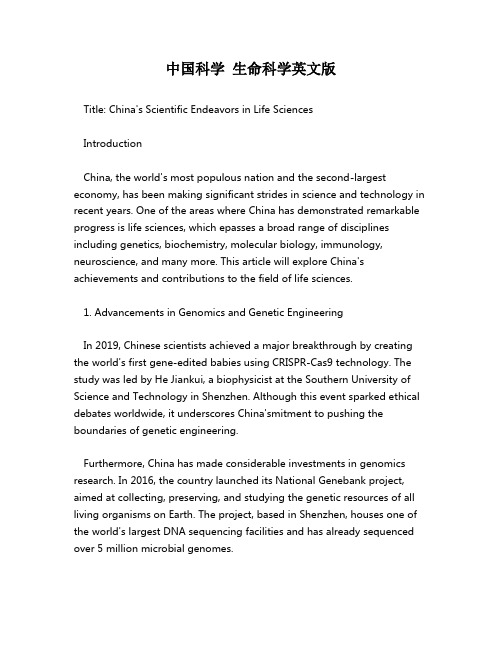
中国科学生命科学英文版Title: China's Scientific Endeavors in Life SciencesIntroductionChina, the world's most populous nation and the second-largest economy, has been making significant strides in science and technology in recent years. One of the areas where China has demonstrated remarkable progress is life sciences, which epasses a broad range of disciplines including genetics, biochemistry, molecular biology, immunology, neuroscience, and many more. This article will explore China's achievements and contributions to the field of life sciences.1. Advancements in Genomics and Genetic EngineeringIn 2019, Chinese scientists achieved a major breakthrough by creating the world's first gene-edited babies using CRISPR-Cas9 technology. The study was led by He Jiankui, a biophysicist at the Southern University of Science and Technology in Shenzhen. Although this event sparked ethical debates worldwide, it underscores China'smitment to pushing the boundaries of genetic engineering.Furthermore, China has made considerable investments in genomics research. In 2016, the country launched its National Genebank project, aimed at collecting, preserving, and studying the genetic resources of all living organisms on Earth. The project, based in Shenzhen, houses one of the world's largest DNA sequencing facilities and has already sequenced over 5 million microbial genomes.2. Biomedical Research and Drug DevelopmentChinese researchers have been actively engaged in biomedical research to develop novel therapeutic strategies for various diseases. For instance, in 2019, Chinese scientists developed a new type of CAR-T cell therapy that showed promising results in treating relapsed or refractory acute lymphoblastic leukemia.Moreover, China has be a global leader in clinical trials. According to a report by IQVIA, a healthcare analytics firm, China surpassed the United States in the number of clinical trials initiated in 2018. With a vast patient pool, streamlined regulatory processes, and growing investment in R&D, China is well-positioned to contribute significantly to the development of new drugs and therapies.3. Synthetic Biology and BioinformaticsSynthetic biology, an interdisciplinary field thatbines principles from biology, engineering, andputer science, is another area where China has shown great promise. Researchers in China are exploring ways to engineer microorganisms to produce biofuels, pharmaceuticals, and other valuablepounds. They are also developingputational tools to design and optimize synthetic biological systems.In addition, China has invested heavily in bioinformatics infrastructure. The China National GeneBank DataBase (CNGBdb) is aprehensive data platform that supports large-scale omics studies and provides open access to genomic data. It plays a critical role in facilitating international collaborations and promoting data sharing in the life sciencesmunity.4. Neuroscience and Brain ResearchNeuroscience is yet another frontier where China is striving to make groundbreaking discoveries. The China Brain Project, launched in 2016, aims to advance our understanding of brain function and develop effective treatments for neurological disorders such as Alzheimer's disease and Parkinson's disease. The initiative involves collaboration among multiple institutions across the country and has received substantial funding from the government.ConclusionChina's rapid advancement in life sciences can be attributed to several factors, including strong government support, substantial financial investments, and a large pool of talented researchers. While there are still challenges to ovee, such as improving research integrity and addressing ethical concerns, China's scientific achievements in life sciences hold great potential for improving human health and transforming the global biotechnology landscape. As China continues to push the frontiers of knowledge in this field, it is poised to play an increasingly influential role in shaping the future of life sciences worldwide.。
Unit 1 Reading and Thinking -高中英语人教版(2019)选择性必修第一册
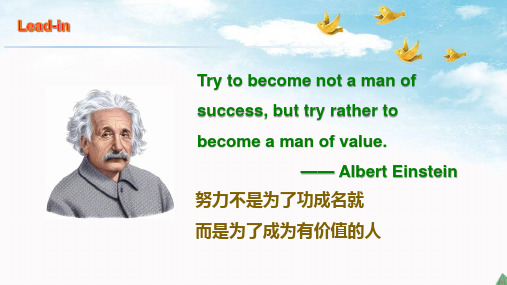
They used__________
_a__l_o_w_e_r__t_e_m_p_e__ra_ture
to draw out the sweet wormwood extract.
The medicine was tested on
m__a_la__r_ia__p_a_t_i_e_n_t_s_.
The medicine became
Tu Youyou received her 2015 Nobel Prize in Physiology [ˌfɪziˈɒlədʒi] (生理学) or Medicine [ˈmedɪsn] .
Some basic information you need know before reading
P2,L3
Academy of Traditional Chinese Medicine in Beijing.
3. Tu Youyou was among the first researchers chosen.
In 1969, she became the head of the project in Beijing P2,L6/L8
extract
Sweet wormwood
artemisinin
Malaria 【reason】:mosquito 【symptoms】chill, fever, sweat
Goals
1 Get the main idea of the text 2 Learn the good qualities of Tu Youyou
7. Tu Youyou and her team members even insisted
on testing the medicine on themselves to make
Unit 1 People of Achievement 句子分析高中英语人教版选择性必修第一册
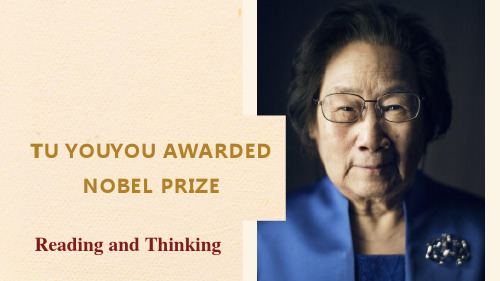
treatment for malaria. 翻译:这种被称为青蒿素的药物很快成为疟疾的标准治疗方法。
Para4
1. According to Tu Youyou, the discovery of artemisinin was a team effort.
翻译:据屠呦呦说,青蒿素的发现是团队的努力的结果。
TU YOUYOU AWARDED NOBEL PRIZE
Reading and Thinking
Title:
award v.授予,奖励 n.奖;奖品/金
award sb sth 两种被动:sb be awarded sth
sth be awarded to sb
TU YOUYOU was awarded Nobel Prize 句子
among the first researchers chosen. 过去分词作后置定语,修饰researchers 表语
短语: with the objective of __目__的__是__…___; 词语:among__在__…__中__(__三__者__及__三__者__以__上__)__;__between 两者之间
短语:be thought to do sth__被__认__为__做__了__某__事___; It is thought that…____被__认__为__…_.______;
翻译:青蒿素已成为疟疾治疗的重要组成部分,而且人们认为,仅在非 洲,青蒿素一年就挽救了10万人的生命。
Para2
1. Tu Youyou, a committed and patient scientist, was born in Ningbo, Tu Youyou的同位语
我国伟大的科学家英文作文
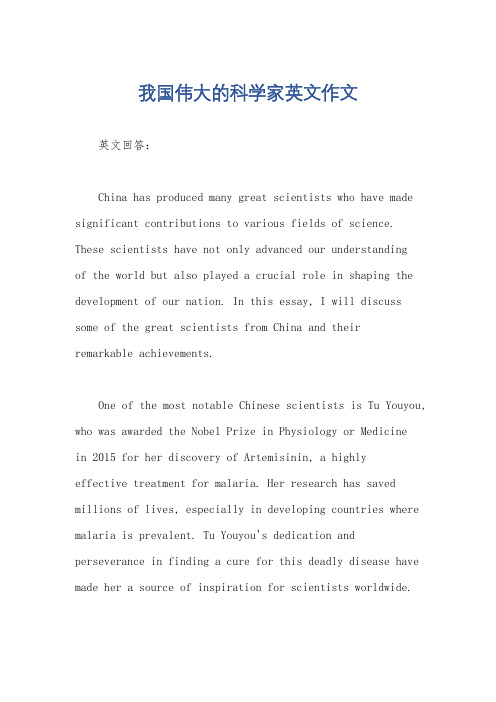
我国伟大的科学家英文作文英文回答:China has produced many great scientists who have made significant contributions to various fields of science. These scientists have not only advanced our understandingof the world but also played a crucial role in shaping the development of our nation. In this essay, I will discuss some of the great scientists from China and theirremarkable achievements.One of the most notable Chinese scientists is Tu Youyou, who was awarded the Nobel Prize in Physiology or Medicinein 2015 for her discovery of Artemisinin, a highlyeffective treatment for malaria. Her research has saved millions of lives, especially in developing countries where malaria is prevalent. Tu Youyou's dedication and perseverance in finding a cure for this deadly disease have made her a source of inspiration for scientists worldwide.Another remarkable scientist is Qian Xuesen, often referred to as the "father of Chinese rocketry." Qianplayed a crucial role in the development of China's space program and was instrumental in the success of thecountry's first satellite launch. His contributions to aerospace engineering have significantly advanced China's technological capabilities and positioned the nation as a global player in space exploration.Furthermore, we cannot overlook the contributions of Wang Zhenyi, a female scientist from the Qing Dynasty who made significant contributions to mathematics and astronomy. Despite the societal constraints faced by women during that time, Wang Zhenyi's passion for knowledge and her exceptional intellect allowed her to excel in these fields. Her groundbreaking work in celestial mechanics and lunar eclipse calculations laid the foundation for future advancements in astronomy.中文回答:中国有许多伟大的科学家,他们在各个科学领域做出了重要贡献。
关于华人科学家的英语作文
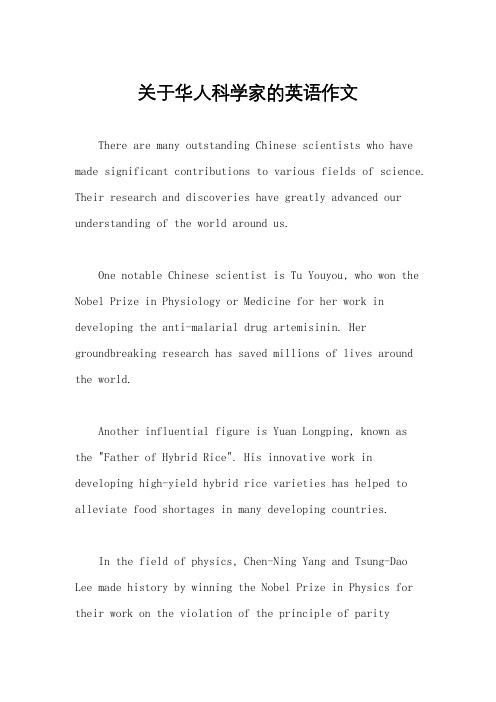
关于华人科学家的英语作文There are many outstanding Chinese scientists who have made significant contributions to various fields of science. Their research and discoveries have greatly advanced our understanding of the world around us.One notable Chinese scientist is Tu Youyou, who won the Nobel Prize in Physiology or Medicine for her work in developing the anti-malarial drug artemisinin. Her groundbreaking research has saved millions of lives around the world.Another influential figure is Yuan Longping, known as the "Father of Hybrid Rice". His innovative work in developing high-yield hybrid rice varieties has helped to alleviate food shortages in many developing countries.In the field of physics, Chen-Ning Yang and Tsung-Dao Lee made history by winning the Nobel Prize in Physics for their work on the violation of the principle of parityconservation. Their research has had a profound impact on the field of particle physics.Chinese scientists have also made significant contributions to the field of space exploration. For example, China's first astronaut, Yang Liwei, made history by becoming the first Chinese national to travel to space.In addition to these well-known figures, there are countless other Chinese scientists who are making important contributions to their respective fields. Their dedication and passion for scientific discovery continue to inspire future generations of scientists around the world.。
我最敬佩的中国科学家英语作文
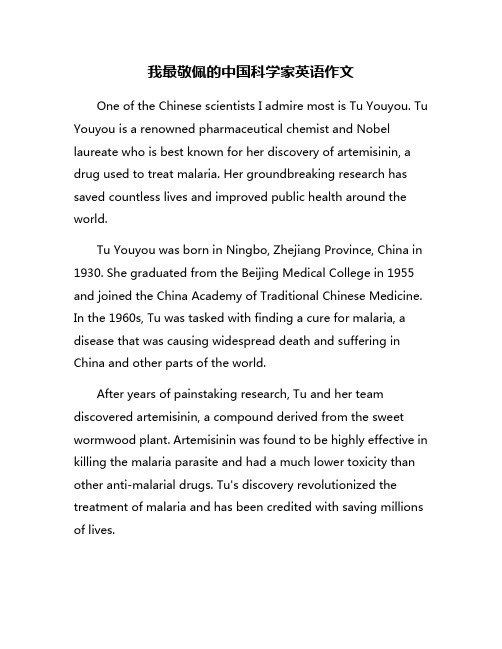
我最敬佩的中国科学家英语作文One of the Chinese scientists I admire most is Tu Youyou. Tu Youyou is a renowned pharmaceutical chemist and Nobel laureate who is best known for her discovery of artemisinin, a drug used to treat malaria. Her groundbreaking research has saved countless lives and improved public health around the world.Tu Youyou was born in Ningbo, Zhejiang Province, China in 1930. She graduated from the Beijing Medical College in 1955 and joined the China Academy of Traditional Chinese Medicine. In the 1960s, Tu was tasked with finding a cure for malaria, a disease that was causing widespread death and suffering in China and other parts of the world.After years of painstaking research, Tu and her team discovered artemisinin, a compound derived from the sweet wormwood plant. Artemisinin was found to be highly effective in killing the malaria parasite and had a much lower toxicity than other anti-malarial drugs. Tu's discovery revolutionized the treatment of malaria and has been credited with saving millions of lives.In 2015, Tu Youyou was awarded the Nobel Prize in Physiology or Medicine for her work on artemisinin. She became the first Chinese woman to win a Nobel Prize in a scientific field and was hailed as a hero in her home country. Tu's humility and dedication to her work have inspired generations of scientists and researchers around the world.I admire Tu Youyou not only for her scientific achievements but also for her perseverance and dedication to improving global health. Her work has had a profound impact on the lives of millions of people, and her legacy will continue to inspire future generations of scientists to strive for excellence in their research. Tu Youyou is truly a role model for scientists everywhere, and I am proud to call her one of my most admired Chinese scientists.。
Unit 1 People of Achievement
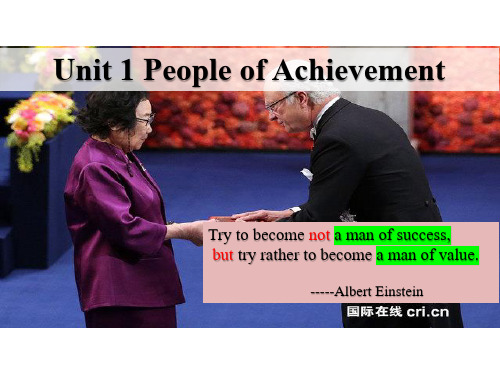
How Tu Youyou and her team discovered artemisinin
Paragraph 5 _C__o_n_c_l_u_s_i_o_n__
WhatTu Youyou thought about discovery and the honor
Read Para.1 and complete the mind map on the worksheet.
1930
1955
1967
1969
Born in Ningbo, China
Chosen to be the first researchers
1971
2015
Tested the medicine on themselves and later on patients
How was artemisinin discovered?
Unit 1 People of Achievement
Try to become not a man of success, but tr value.
-----Albert Einstein
➢ Who is the woman in the photo? ➢ What is happening in the photo? ➢ What’s the reaction of people
